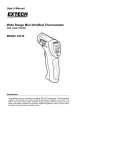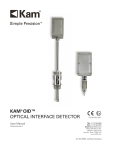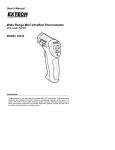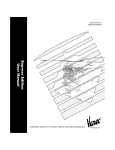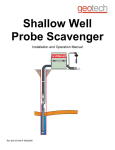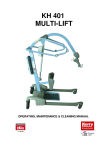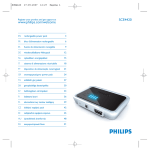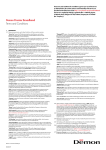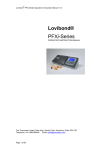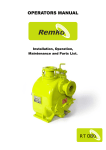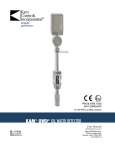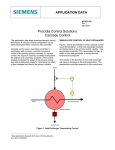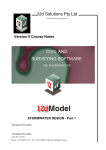Download KAM® CHA™ COLORIMETER/HAZE ANALYZER
Transcript
PTB 04 ATEX 1027 KAM® CHA™ COLORIMETER/HAZE ANALYZER API COMPLIANT User Manual TEL +1 713 784 0000 FAX +1 713 784 0001 Email [email protected] CHAMANUAL-0413 KAM CONTROLS, INC. 3939 Ann Arbor Drive Houston, Texas 77063 USA www.KAM.com TABLE OF CONTENTS SECTIONTITLEPAGE 1 Introduction 2 •Available Models and Mounting Options 2 •Theory of Operation 2 •Features 3 •Applications 3 2 Specifications •Specifications •Dimensional Drawings 4 4 5 3 Installation 7 •Main Line 7 •Removal 9 •Wiring 10 •4-20 mA Outputs 11 4Maintenance12 5 Communications Interface 13 6 Additional Drawings 14 CAUTION: When installing the CHA™ sensor in a pipeline containing petroleum products, petro-chemicals, waste waters with the presence of pressure & temperature, and high-pressure steam refer to the Pipeline Operators’ “Health, Safety and Environmental Policy Procedures” to ensure safe installation. KAM CONTROLS, INC. reserves the right to make changes to this document without notice. CHAMANUAL 0413 1 KAM CONTROLS, INC. INTRODUCTION AVAILABLE MODELS and MOUNTING OPTIONS FIG. 1-1 Fullopening ball valve Rectractable CHA™ on a main pipe, with 2", 3", or 4" flanged seal housing FIG. 1-2 FIG. 1-3 Fullopening ball valve Rectractable CHA™ on a main pipe, with 2" MNPT seal housing CHA™ FT Flow Through with 1" ANSI 150 flanges THEORY OF OPERATION Color variations in refined products indicate impurities and/or the presence of water. Refined products are often prone to haze or diffused water contamination due to cooling towers which use water and in turn can saturate the product. This can be a significant liability as color differentiation can be easily detected by the end user. The KAM® CHA™ Colorimeter/Haze Analyzer is the ideal quantitative solution for monitoring both the color of refined products, including dyed product, and the presence of haze (trace/dissolved water) in pipelines following the refining process. The KAM® CHA™ detects interface color variations within 1%, and unlike most colorimeters can detect the entire range of visible color as defined by CIE 1931 (International Commission on Illumination). The simplicity of design and quality of engineering employed in the Colorimeter/Haze Analyzer mean there are no moving parts. Using long-lasting LED light sources ensures long-term, stable performance with limited maintenance and power requirements. In addition, locating the electronics within an explosion-proof enclosure directly on the atmospheric end of the optical probe creates a complete and compact unit with maximum installation flexibility. The KAM® CHA™ easily installs where other colorimeters, weighed down by large electronics/computer units, cannot. The five LED sources (Red, Blue, Green, Yellow, and IR) send light via fiber optics to the sensor end inserted into the pipeline or analyzer loop. These beams of light pass through a 25mm window of pipeline fluids and then are reflected back through fiber optics to the electronics enclosure for a total path of 50mm. CHAMANUAL 0413 2 KAM CONTROLS, INC. INTRODUCTION CONTINUED KAM uses four LED's for color determination to increase the accuracy over three-color (RGB) models. The fifth (IR) LED provides haze detection. The disparity in light output versus light reflected back is then converted into an electronic or optical signature which is amplified and sent to the computer. The computer in turn utilizes a mathematical formula to determine the exact color and haze (turbidity) of the fluid in the pipeline. Final color measurement from the KAM® CHA™ can be expressed as haze plus three color (X, Y, Z, CIE 1931) or in several other industry-standard color scales including, Saybolt, Platinum and Cobalt, and ASTM 1500 (see Specifications, Section 2). The computer automatically adjusts for electronic noise and any LED fluctuations. Because the absorption rates of the different colored fluids vary resulting in different signal strengths, the computer also automatically adjusts the amplification or gain accordingly. Measurement is fully automatic without the need for operator intervention or supervision. The output signal can be sent to the SCADA, PLC’s, or to a Central Control Room for logging or display on chart recorders or monitors. The KAM® CHA™ probe can be installed in an analyzer loop or in the main line, and because it’s easily mounted through a full-opening ball valve, you can insert or retract the probe without having to ever drain the pipe. FEATURES • • • • • • User friendly Low power Explosion proof Low maintenance Compact format includes requisite electronics Long-lasting LED light sources APPLICATIONS • Batching • Interface • Production • Transmix/regrade reduction • Quality control in refined products including dyed and undyed motor and aviation gasoline, jet propulsion fuels, naphthas and kerosine • Quality control in pharmaceutical white oils and petroleum waxes • Brine detection in LPG transfer from storage caverns CHAMANUAL 0413 3 KAM CONTROLS, INC. SPECIFICATIONS Media: Refined products Material: Wetted parts–316 stainless steel, sapphire Power: 12–24 VDC 20 Watts max Communication Interface: RS-485 reflects values for Haze plus designated color scale (see Color Range) Fluid temperature: -40º to 200ºF (-40º to 93ºC) Electronics temp.: -22º to 185ºF (-30º to 85ºC) Pressure ratings: ANSI 150, 300, 600 Accuracy: Haze ± 5%, Color ± 1% Repeatability: Haze ± 1%, Color ± 1% Reproducibility: Haze ± 1%, Color ± 1% Haze Range: 0-100% Color Range: Complete range of: ASTM D 1500; ASTM D 156 (Saybolt); ASTM D 1209 (APHA Platinum-Cobalt) Mounting: ¾", 1", 1½", and 2" FNPT Flow Through (Metric sizes available) 2" MNPT Seal Housing 2", 3", or 4" Flanged Seal Housing Sensor Dimensions: 3.5" x 1.25"Ø (90mm x 32mm), Flow through 5.8" x 2.75"Ø (148mm x 70mm) EX enclosure: 3" x 6" x 3" (76mm x 152mm x 76mm) Shaft length: 12" to 60" – Off-the-shelf lengths are 12", 24", 36", 48", and 60" (305mm to 1524mm) (Off-the-shelf 609.6mm, 762mm, 914.4mm, 1219mm, 1524mm) Pipe size: ¾" to 48" (20mm to 1200mm) Weight: from 20 lbs. (9kg) CHAMANUAL 0413 4 KAM CONTROLS, INC. SPECIFICATIONS CONTINUED DIMENSIONAL DRAWINGS FIG. 2-1CHA™ SENSOR SL C A Seal Housing B D ¾" FNPT E F Shaft Length ± .5" Sensor Profile TABLE 2-2 FLANGE SIZE AND CLASS (SL) 150 300 900 600 " INCHES MM INCHES MM INCHES MM INCHES MM 2 8.40 213 8.50 216 8.90 226 9.40 240 3 8.60 218 8.75 222 9.15 232 9.40 240 4 8.60 218 8.90 226 9.40 240 9.65 245 TABLE 2-3 DIMENSIONS INCHES MM A 1.25 32 B 3.5 90 C 7.25 184 D 4.7 119 E .47 12 F 1 25 CHAMANUAL 0413 Shaft Lengths are available in .5" (12.7mm) increments. Standard sizes are 24", 30", 36", 48", and 60". (609.6mm, 762mm, 914.4mm, 1219mm, 1524mm) 5 KAM CONTROLS, INC. SPECIFICATIONS CONTINUED FIG. 2-4 FLOW THROUGH CHA™ D C A ANSI FLANGES B TABLE 2-5 DIMENSIONS INCHES MM A 11.8 299 B 11 279 C 7.25 184 D 4.7 119 CHAMANUAL 0413 6 KAM CONTROLS, INC. INSTALLATION PRIOR TO INSTALLATION Remove all the protective packaging materials , and ensure that the CHA™ sensor was not damaged during transit. MAIN LINE INSTALLATION The KAM CHA™ sensor should be installed according to FIG. 3-1, ideally at the 3 or 9 o'clock position within the pipeline. Installing the instrument horizontally prevents the long-term buildup of any sediment on the sapphire windows. A full-opening ball valve is used to isolate the CHA™ sensor from the pipeline during installation or removal. The seal housing of the CHA™ sensor allows the probe to be inserted and removed from the pipe under pressure and flow conditions. It is the user’s responsibility to ensure that the CHA™ sensor be placed at the most representative point within the flow profile. The CHA™ sensor should be inserted so that the window of the probe is fully located within the pipeline. ® FIG. 3-1 KAM® CHA™ INSTALLED ON A MAIN PIPE Locking Collar Seal Housing Full-opening Ball Valve Socket Cap Screw NOTE: Line pressure must be below 100 psi for CHA installation and removal. Pressure above 100 psi could cause the probe to forcibly move outward from the pipeline risking bodily injury and/or damage to the probe. 1. Prior to mounting verify that the tip of the sensor is all the way inside the seal housing. (FIG. 3-2,3-3) 2. If sensor is not fully enclosed inside the seal housing, pull the shaft back until the probe is all the way in the seal housing and tighten the socket cap screws on the locking collar. This will prevent the CHA™ shaft from sliding and the probe from getting damaged during mounting. CHAMANUAL 0413 FIG. 3-2 FIG. 3-3 7 KAM CONTROLS, INC. INSTALLATION CONTINUED 3. Measure the distance (D1) from the outside diameter of main pipe to the end of the connection where the CHA™ sensor is going to be installed. FIG. 3-4. FIG. 3-4 D1 D1 4. Calculate the minimum insertion distance for the CHA. Minimum insertion distance (MID) = D1 + Wall Thickness + 2" Example for D1=16", pipe WT =1/4", Seal Thickness=1/8": MID = 16 + 1/4 + 1/8 + 2 MID = 18 3/8" FIG. 3-5 5. Measure the calculated MID from the top of the seal clamp and place a mark with a permanent marker or tape on the Shaft. FIG. 3-5. MID 6. Bolt or screw the CHA™ sensor to the valve or designated installation location. (KAM CONTROLS recommends using thread sealant and not Teflon tape for the threaded CHA™). 7. Open full opening valve. 8. Loosen Socket Cap Screws on the locking collar. REMINDER: Line pressure must be below 100 psi for CHA installation and removal. CHAMANUAL 0413 8 KAM CONTROLS, INC. INSTALLATION CONTINUED 9. Push CHA™ sensor in until the mark is at the top edge of the locking collar. Ensure that CHA™ flow indicator is aligned with pipeline flow direction. FIG. 3-6. FIG. 3-6 Mark Hex Nuts 10. Re-tighten the Socket Cap Screws with a torque of 750-800 lb-in or 62.5 to 66.6 lb-ft. 11. Tighten the Hex Nuts on the top of the Locking Collar one half turn. These nuts should never be over-tightened. Their major function is to apply light pressure on the chevron packing to ensure a seal between the seal housing body and the insertion shaft. REMOVING THE CHA™ SENSOR 1. To remove the CHA™ sensor, first disconnect all electrical connections to the CHA™ enclosure. 2. Make sure that the line pressure is below 100 psi. Then, slowly and with caution loosen the Socket Cap Screws on the Lock Down Collar. NOTE: Once the Socket Cap Screws have been loosened, the CHA shaft may push out from the line. If pressure in the line is above 100 psi, it may do so with enough force to cause bodily injury or damage to the instrument. 3. Slide the CHA™ sensor upward until it stops and the probe rests inside the seal housing. Fig. 3-7. The mechanical stop prevents further movement or ejection of the shaft and/or sensor. 4. Next, close the Full-opening Ball Valve tightly. The CHA™ sensor may now be unbolted from the system. FIG. 3-7 Mechanical Stop Socket Cap Screws CHAMANUAL 0413 9 KAM CONTROLS, INC. INSTALLATION CONTINUED WIRING FIG. 3-8 ASTM SAYBOLT Pt/Co HAZE 1 2 3 4 J5 LOOP1 J7 LOOP2 JUMPERS TO SELECT SIGNAL/ SCALE FOR 4-20 mA OUTPUTS KAM CHA 3939 Ann Arbor Drive Houston, Texas 77063, USA +1 713 784 0000 www.KAM.com RTN 485 + Loop1 IN 485 - Loop1 IN GND Loop2 (–) RTN Vin (+) Loop2 Vin Rev 2.01 12/2012 Made in USA POWER CONNECTIONS COMMUNICATION INTERFACE 4-20 mA CONNECTIONS POWER COMMUNICATION INTERFACE 12 or 24 VDC (5 watts max) RS–485 CAUTION: When electronics enclosure is open, be extremely careful to avoid any contact with interior fiber optic connections. Failure to do so could result in the CHA malfunctioning. CHAMANUAL 0413 10 KAM CONTROLS, INC. INSTALLATION CONTINUED OUTPUTS LOOP1 and LOOP2 can output signals for any 2 of 4 different scales: ASTM, Saybolt, Platinum/Cobalt, and Haze. To select which signal or scale is associated with which 4-20 mA output, insert a jumper across the pins next to the label for the desired scale. See Fig. 3-9. Place ONE jumper in J5 and one in J7 to select two scales total. Inserting more than one jumper for either LOOP or inserting the jumper across two inputs or two outputs will result in the malfunctioning of the instrument. FIG. 3-9 ASTM SAYBOLT Pt/Co HAZE SCALE 1 2 3 4 J5 LOOP1 J7 LOOP2 JUMPER INPUT JUMPER OUTPUT PROPER JUMPER PLACEMENT ACROSS INPUT AND OUTPUT KAM CHA COLOR SCALE RANGES 3939 Ann Arbor Drive SCALE Houston, Texas 77063, USA ASTM +1 713 784 0000 Saybolt www.KAM.com Platinum/Cobalt Haze RANGE .5 to 8 -30 to 16 0 to 500 0 to 100 RTN 485 + Loop1 IN 485 - Loop1 IN GND Loop2 Rev 2.01 12/2012 Made in USA CHAMANUAL 0413 11 KAM CONTROLS, INC. MAINTENANCE CLEANING AND INSPECTION Under normal operation, the KAM CHA should not require cleaning, unless pipeline usage is limited to a small number of products. Gasoline products or jet fuel in the pipeline will clean the CHA without removal. To remove any oil residues for visual inspection use a clean cloth with oil solvent or part washer. Preferred solvents include, any petroleum solvent such as mineral spirits, xylene, toluene, gasoline, or diesel. Do not use WD40 or other chemicals. If you have a question regarding cleaning solvents, please contact KAM CONTROLS directly at +1 713 7840000, or email: [email protected] CHAMANUAL 0413 12 KAM CONTROLS, INC. COMMUNICATIONS INTERFACE HYPERTERMINAL PROMPTS FOR RS-485 CONNECTION 1. Once Hyperterminal software is launched, a dialogue window will prompt you to "Enter a name and choose an icon for the connection." Name the connection whatever you want, for example "CHA 1." Ignore the choose icon option. Hit OK. 2. The "Connect To" dialogue box will now appear. On the last line where it says "Connect using" choose the name of the communication port connected to the CHA via RS-485 from the drop-down menu. Hit OK. 3. The "Port Settings" dialogue box will now appear. Enter the following values from the drop-down menu: Bits per second: 1200 Data bits: 7 Parity: Even Stop bits: 2 Flow control: None Hit OK. 4. A blank screen with prompt will now open. To display CHA readings type one of three prompts, E1, E2, or E3. E1: Displays values for Z, Y, Z, and T (haze) E2: Displays values for ASTM, Saybolt, PtCo (Platinum Cobalt), and T (haze) E3: Displays all values CHAMANUAL 0413 13 KAM CONTROLS, INC.














